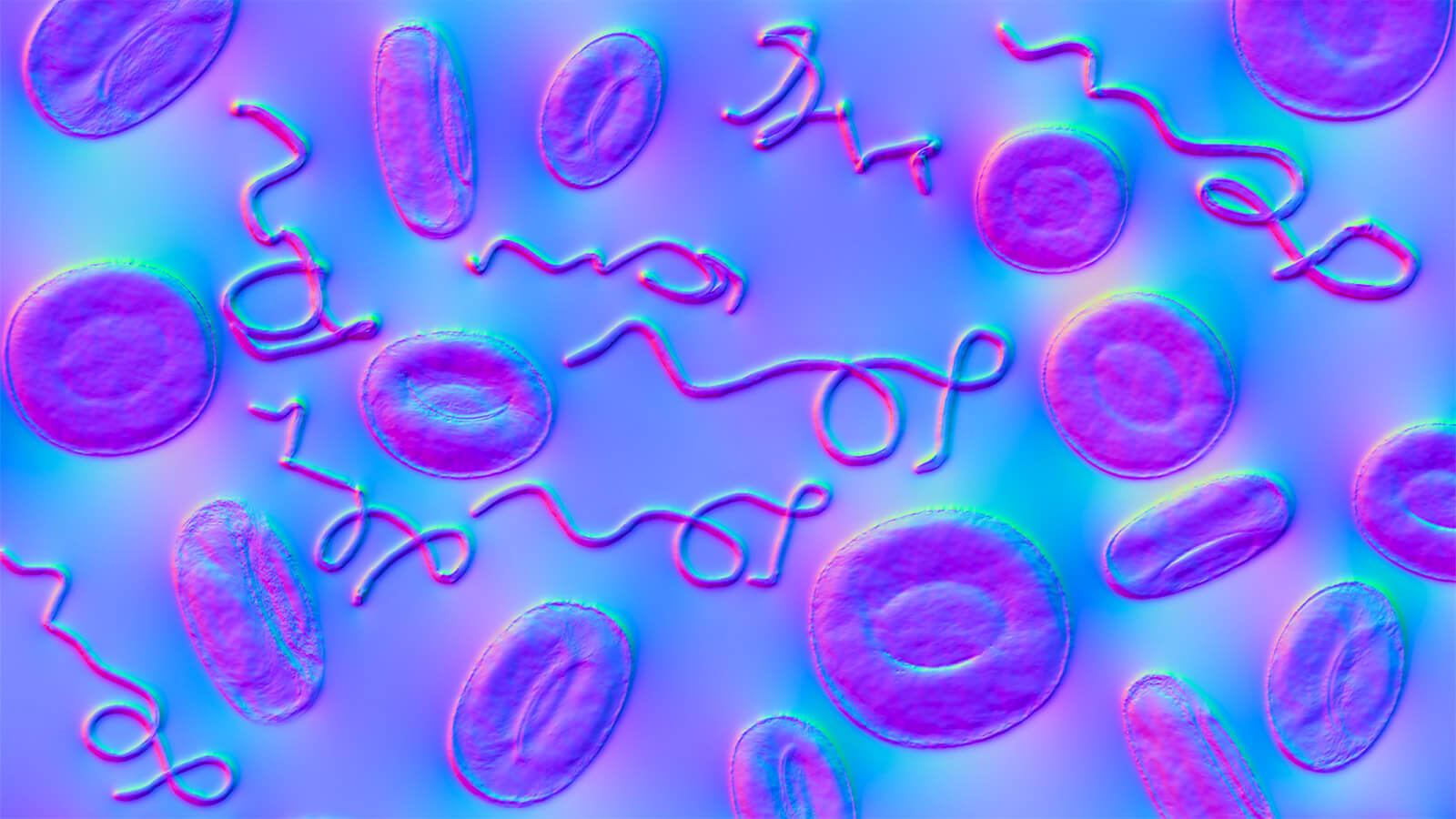
Symptomatology
Lyme disease is one of the most complex multisystem conditions, affecting various systems such as the musculoskeletal, cutaneous, cardiac, and nervous systems, presenting a variety of clinical manifestations at different stages.
Although patients with B. burgdorferi infection can be asymptomatic, most cases of Lyme disease fall into three major stages:
A. Early localized disease (usually < 30 days post-exposure)
B. Early disseminated disease (< 6 months post-exposure)
C. Late disseminated disease (> 6 months post-exposure) 8.
STAGE 1
Early Localized Disease (< 30 days)
The incubation period ranges from 3 to 32 days, after which a characteristic skin rash known as erythema migrans appears, accompanied by fever, headache, malaise, and myalgia.
Erythema Migrans
The rash is the hallmark of Lyme disease. It typically starts as a central red spot, surrounded by a clear circle with a larger outer red circle over 5 cm in diameter. The rash is flat and usually non-itchy. The skin rash signifies the spread of infection into the skin tissues. It usually appears at the site of the tick bite within 3 to 30 days 1. Similar but smaller rashes may appear three to five weeks later as the bacteria spread through tissues 2. Sometimes, the rash is just a red spot 3. Early symptoms are flu-like. Approximately 50% of people with Lyme disease experience flu-like symptoms within a week of infection 4.
Fatigue
Fatigue, exhaustion, and lack of energy are the most common symptoms. Lyme fatigue may feel different from regular fatigue, where you can pinpoint activity as a cause. This fatigue seems to engulf your body and can be very intense 5.
Arthralgia
Joint pain and stiffness, often intermittent, are common symptoms of Lyme disease. Joints become swollen and painful. Stiffness or limitation in joint movement due to joint pain may also occur 6. At the same time, the pains may migrate from knees to shoulders or neck. Bursitis is also not uncommon 7.
Fever, night sweats, Headache 8
STAGE 2
Early Disseminated Disease (< 6 months)
After several weeks to months, neurological and cardiac abnormalities may be reported in 8-15% of patients.
Multiple erythema migrans 9
Fever 10
Arthralgia and myalgia 11
Headache 12
Lymphadenopathy 13
Atrioventricular block 14
Tachyarrhythmias 15
Myopericarditis 16
Myocardial dysfunction 17
Aseptic meningitis 18, 19
Cranial neuropathy (especially facial nerve palsy) 20
Motor or sensory radiculopathy 21
Painful radicular syndromes
Bursitis
Ocular symptoms (e.g., double vision)
STAGE 3
Late Disseminated Disease (> 6 months)
Patients may present with chronic monoarticular or oligoarticular arthritis, involving large joints, especially the knee. The most severe manifestations of this condition are Lyme neuroborreliosis, reported in 10-15% of individuals with localized erythema migrans.
Oligoarticular arthritis 22
Encephalopathy 23, 24
Axonal polyradiculoneuropathy 25, 26
Chronic encephalomyelitis 27, 28
Cutaneous symptoms 29, 30, 31, 32
The symptoms
of Lyme disease
according to the International Lyme and Associated Diseases Society (ILADS) guideline 33
Bibliography
2. Donta, Sam T. "Late and chronic Lyme disease." Medical Clinics of North America 86.2 (2002): 341-350.
4. https://emedicine.medscape.com/article/330178-clinical
2. Donta, Sam T. "Late and chronic Lyme disease." Medical Clinics of North America 86.2 (2002): 341-350.
3. Kandhari, Rajat, Sanjiv Kandhari, and Sudhir Jain. "Borrelial lymphocytoma cutis: A diagnostic dilemma." Indian journal of dermatology 59.6 (2014): 595.
4. https://emedicine.medscape.com/article/330178-clinical
5. Donta, Sam T. "Issues in the diagnosis and treatment of lyme disease." The open neurology journal 6 (2012): 140.
6. Shapiro, Eugene D. "Lyme disease." New England Journal of Medicine 370.18 (2014): 1724-1731.
7. https://www.lymenet.org/BurrGuide200810.pdf
8. Hatchette, T. F., I. Davis, and B. L. Johnston. "Clinical aspects of Lyme disease: Lyme disease: clinical diagnosis and treatment." Canada Communicable Disease Report 40.11 (2014): 194.
9. Nowakowski, John, et al. "Long-term follow-up of patients with culture-confirmed Lyme disease." The American journal of medicine 115.2 (2003): 91-96.
10. Bergström, Sven, and Johan Normark. "Microbiological features distinguishing Lyme disease and relapsing fever spirochetes." Wiener klinische Wochenschrift 130.15 (2018): 484-490.
11. Puius, Yoram A., and Robert A. Kalish. "Lyme arthritis: pathogenesis, clinical presentation, and management." Infectious disease clinics of North America 22.2 (2008): 289-300.
12. Moses, James M., Robyn S. Riseberg, and Jonathan M. Mansbach. "Lyme disease presenting with persistent headache." Pediatrics 112.6 (2003): e477-e479.
13. Smiyan, Svitlana, et al. "Sjögren’s syndrome and lymphadenopathy unraveling the diagnosis of Lyme disease." Reumatologia 57.1 (2019): 59.
14. Sigal, Leonard H. "Early disseminated Lyme disease: cardiac manifestations." The American journal of medicine 98.4 (1995): 25S-29S.
15. Grzesik, Piotr, Barbara Oczko-Grzesik, and Lucjan Kepa. "Cardiac manifestations of Lyme borreliosis." Przeglad epidemiologiczny 58.4 (2004): 589-596.
16. Nagi, Kiran S., Ritu Joshi, and Ranjan K. Thakur. "Cardiac manifestations of Lyme disease: a review." The Canadian journal of cardiology 12.5 (1996): 503-506.
17. Fish, Airley E., Yuri B. Pride, and Duane S. Pinto. "Lyme carditis." Infectious disease clinics of North America 22.2 (2008): 275-288.
19. Tuerlinckx, David, et al. "Clinical data and cerebrospinal fluid findings in Lyme meningitis versus aseptic meningitis." European journal of pediatrics 162.3 (2003): 150-153.
20. https://www.cdc.gov/mmwr/pdf/ss/ss5710.pdf
21. Halperin, John J. "Lyme disease and the peripheral nervous system." Muscle & Nerve: Official Journal of the American Association of Electrodiagnostic Medicine 28.2 (2003): 133-143.
22. Arvikar, Sheila L., and Allen C. Steere. "Diagnosis and treatment of Lyme arthritis." Infectious Disease Clinics 29.2 (2015): 269-280.
23. Hengge, Ulrich R., et al. "Lyme borreliosis." The Lancet infectious diseases 3.8 (2003): 489-500.
24. Halperin, John J., et al. "Lyme borreliosis‐associated encephalopathy." Neurology 40.9 (1990): 1340-1340.
25. Kindstrand, E., et al. "Polyneuropathy in late Lyme borreliosis‐a clinical, neurophysiological and morphological description." Acta neurologica scandinavica 101.1 (2000): 47-52.
26. Logigian, Eric L., Richard F. Kaplan, and Allen C. Steere. "Chronic neurologic manifestations of Lyme disease." New England Journal of Medicine 323.21 (1990): 1438-1444.
27. Uhde, Melanie, et al. "C-reactive protein response in patients with post-treatment Lyme disease symptoms versus those with myalgic encephalomyelitis/chronic fatigue syndrome." Clinical Infectious Diseases 67.8 (2018): 1309-1310.
28. Di Domenico, Enea Gino, et al. "The emerging role of microbial biofilm in Lyme neuroborreliosis." Frontiers in neurology 9 (2018): 1048.
29. Asbrink, E.; Hovmark, A.; Hederstedt, B.: The spirochetal etiology of acrodermatitis chronica atrophicans Afzelius. Acta Derm Venereol 64 (1984), 506–512
30. Berger, B. W.: Dermatologic manifestations of Lyme disease. Rev Infect Dis 11 (1989), 1475–148.
31. Mullegger, R. R.: Dermatological manifestations of Lyme borreliosis. Eur J Dermatol14 (2004), 296–309
32. Trevisan, G.: Atypical dermatological manifestations of Lyme borreliosis, acta dermatovenerologica. 10 (2001).
33. ILADS Working Group. "Evidence-based guidelines for the management of Lyme disease." Expert review of anti-infective therapy 2.sup1 (2004): S1-S13.
One of Europe's Premier Lyme Disease Treatment Centers Operates at ImunoMedica Clinic
How can you become a patient of our clinic?
Throughout the whole process, from your initial contact, through treatment and after you leave our clinic, our patient coordinators will guide you through the steps and support you with all their expertise, attention and kindness.
*
We are here to help you
Our patient coordinator will contact you soon
Phone: +40.771.518.946, e-mail: office@imuno-medica.ro












